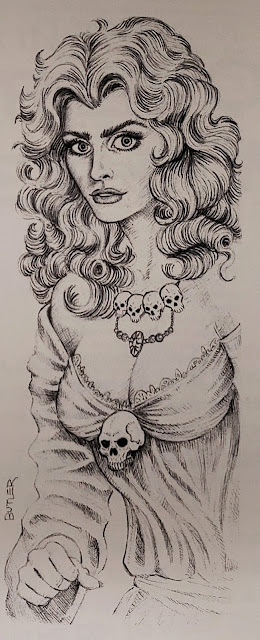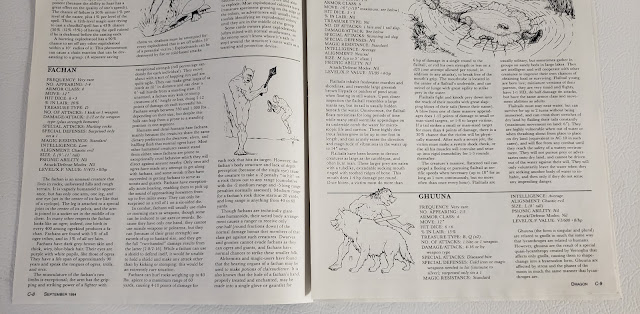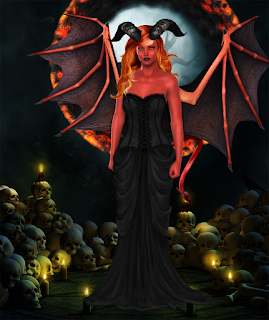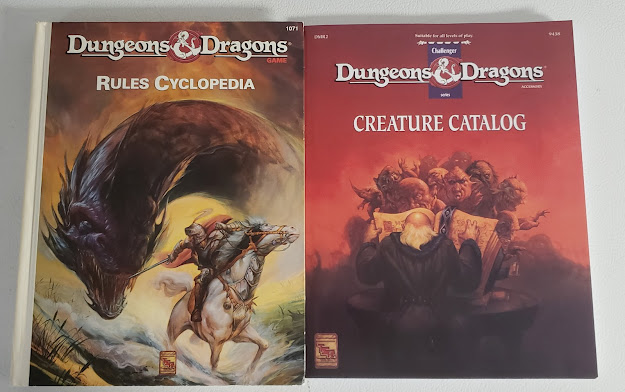Well, last month we all learned about the death of Len Lakofka and I wanted to mark it in some way. I thought maybe this would be a good way of doing that.
Introduction
A little bit of background here on This Old Dragon. I had purchased a couple of large gaming collections over the last few years. My brother also gave me a box of Dragons in really bad shape. After combining, keeping some, selling off others, and tossing (yeah, had too) ones that were in terrible shape I was left with about 100 or so Dragons that were in pretty bad shape. Most were missing covers, many are missing pages and maybe one or two are fully intact. In This Old Dragon, I am grabbing an issue out at random and reviewing them. I can only review what I have, so if it is missing I won't talk about it. The only exception I make is the covers. If I feel too much is missing or something important is missing I'll check my Dragon-Magazine CD-ROM.
One Man's God is my feature on the various mythos, gods, and goddesses as presented in the AD&D 1st Edition Deities & Demigods. Here I look through the various gods and monsters and see which ones would be better classified as AD&D 1st Ed Demons as defined by the Monster Manual. When there is nothing I look to the original myths to see what we can find.
Today I am going to do both features for the Suel Pantheon.
This Old Dragon: The Suel and their Gods
This feature began in Dragon Magazine #86 from June 1984 to #92 in December 1984. Or in my prime AD&D time. The feature was authored by Len Lakofka and had Gary Gygax's official stamp of approval on them. Len had also created the L Series of modules and the Lendore Isles. So in my mind, that meant there was still active Suel worship in the Isles and that the wizard on the cover of L1 The Secret of Bone Hill was a worshiper of Wee Jas. But I am getting ahead of myself.
The Suel made their very first appearance in the pages of the first The World of Greyhawk folio as an ancient empire whose language was still used. The Gods would get names, but not information blocks in the boxed set World of Greyhawk Fantasy Game Setting. Soon after we began to get the gods in Dragon.
Before I get into the Gods proper, there are a few other issues we should cover.
This issue gives us a very new looking Leomund's Tiny Hut from Len Lakofka. This is so new in fact that I think this might be the first-ever Tiny Hut article. There is an introduction by Gary himself. This installment covers giving more depth to the humans and languages of the Flanaess. Cool article and one that every Greyhawk DM should have handy. Actually, it is good for most DMs. The article is pretty long, longer than most Tiny Hut articles in my memory.
This is the article that lets us know that Suel are very near albino looking save with shades of violet for eyes. Given that these were the forerunners of the Lawful Evil Scarlet Brotherhood then it was kind of obvious that the Empire was some kind of a cross between the Melnibonéans and the Nazis.
In his From the Sorcerer's Scroll Gary gives us some more details on the Suel and how they moved across the continent to the Snow, Frost, and Ice Barbarian lands and how these peoples are the purest strains of the Suel bloodline. If the picture being painted is these are not particularly nice people then consider the painting done. Still, there are some interesting tidbits and it made me want to find out more and it made me want to find an offshoot of the Suel that weren't such xenophobic dicks.
I think Len made a lot of that possible in his series.
Dragon #86 was one of those issues that punched way above its weight class. I mean there was just so much in this that one would be excused if Len's article, Presenting the Suel Pantheon, was ignored. Here we are introduced to Lendor (the chief god) and Norebo (the god of thieves). The gods are presented in the same format as the D&DG gods; which sadly in the early 80s meant these were creatures that could be fought and could be killed. But I want to ignore that for bit and instead focus on what is really one of these first full (A)D&D pantheons. In the 3e era some of these gods would be folded back into the "Greyhawk" pantheon, but here they are on their own with their fellow Suel.
Lendor has a solid Odin feel to him and Norebo (maybe one of the most popular gods during my AD&D years) is like a slightly less evil Loki. This trend is going to continue.
Dragon Issue #87
This issue covers the gods Kord and Phaulkon. Kord is the son of the lesser gods Phaulkon and Syrul, though he himself is a greater god. He is also one of the most popular and worshiped Suel god. He is the god of battle, swordsmanship, and berserk rage. He has thousands of semi-mortal/semi-divine children, any of which who meet his challenges can claim demi-god status. If you are thinking Thor with a sword mixed with Conan then you are not too far off. Since this issue also featured the Ecology of the Dryad, I figured that Kord had a particular affection for them. In fact I am going to say that the Korreds, who would later appear in the Monster Manual II, began as the offspring of Kord and the multitude of dryads he..uh.seduced. Sure let's go with that word.
Phaulkon is the winged god of air, flying and archers. If Kord is the superior melee combatant, then Phaulkon is the superior missile combatant. He can speak with any bird or any creature that uses wings to fly, including demons and devils. He is Chaotic Good so I always felt there would a natural rivalry between Phaulkon and Pazuzu, both striving for control over the air and air creatures.
Dragon Issue #88Here we get Syrul, Fortubo, and Wee Jas the unrequited love of my life (circa age 14). Wee Jas, of course, grabbed my attention like nothing else in this issue. She was a gorgeous goddess of magic known as the Witch Queen? How in the hell was I supposed to ignore that? For years I thought this art was a Larry Elmore piece, but it is actually Jeff Butler. I think the wide eyes are what really sets this piece off. Bella Donna indeed.
Of all the Suel gods it is Wee Jas that has had her best life in the years following this publication. What do we learn about her? Well at this point she is still a greater goddess of magic and death. She knows every magic-user spell and all other spells to 5th level (why only 5th??). She can cast up to 9 spell levels worth of spells each round; so 1 9th level spell or 9 1st level or any combination. She has 90% magic resistance and a globe of invulnerability that floats around her. She is attractive (Charisma 20) and always appears so.
If she is anything she is very lawful. To the point where good and evil are mostly meaningless to her just as long as you are not chaotic. In fact, she pretty much hates anything chaotic except for the chaotic neutral god Norebo; who is her brother (or half-brother) and occasional lover. Gods. Go figure.
In the letters section in a couple Dragons later it is mentioned that Norebo's entry mentions Wee Jas, but Wee Jas' doesn't. The editors reply that it is because Wee Jas is loathed to admit it and Norebo could also be bragging.
Also, have a look at her name "Wee Jas" or "Wee" and "Ja" or "Oui Ja". She is the goddess of the Ouija board as well. Magic. Death and Spirits. Clever Gary.
Syrul is the evil goddess of lies and false promises. Fortubo is the dwarf-like god of mountains, stone, and metals. Neither are half as interesting as Wee Jas. Well, Fortubo was interesting on his own, but not compared to my 1984 girlfriend here.
To stretch out Norse analogies a bit Wee Jass is a bit of Hel and Freyja combined. But there is also a good amount of Hecate in her.
Since Len also created the Death Master NPC class I figured at least a few Death Masters were aligned with Wee Jas instead of Orcus. This was part of their strong rivalry for the dead.
This issue continues those wonderful Denis Beauvais "Chess" covers. So therefore the Suel Empire invented chess on Oerth.
In this issue, Len features Pyremius, Beltar, and Llerg. It is interesting to see which of these gods survived to today. These gods made it to the 3.x Living Greyhawk Gaz and Complete Divine. Pyremius is the God of Fire, Poison, and Murder. He looks like a conehead to be honest. The next goddess, Beltar, just has a Conehead sounding name. She is the Goddess of Deep Caves, Pits, and Malice. She appears as an old crone, a beholder or as a Type V, or Marilith, demon. I would say she has a few of both types of creatures under her command. Llerg is the God of Beasts and Strength and appears a bear-like man. He seems like a decent enough god. He prefers to live on his own in the woods and deals more with animals and other beasts. I was half-tempted back in the day to also make him the God of Bears, in the sub-culture sense. Now I am fully tempted.
This issue also gave us the first Creature Catalog from Dragon. Here are a number of creatures that could easily be re-classified as demons; at least in the OMG sense. These include the Fachan, the Ghuuna (already has a demonic origin), and the Utukku. Beltar in particular would have Utukku under her control. I went back to the original myths and did my own Utukku and Umu demons for Ghosts of Albion and a completely different version was created for Pathfinder.
Before we get to the Suel article proper, Out on a Limb covers the seemingly impossible relationship between chaotic to the core Norebo and hard-line lawful Wee Jas. Kim Mohan makes two suggestions. First, opposites attract and Norebo has a big mouth. Second, they goofed. I like the idea of them being together, to be honest. Gods need to be complicated. Though given that Norebo and Wee Jas are also half-siblings, I guess really complicated. Well, no one bats an eye when it happens in Egyptian and Greek pantheons.
You can also go with Mike's take on it over at Greyhawkery.
On to the article proper we have a collection of sea gods. Phyton, Xerbo, and Osprem. Phyton is the God of Beuty and Nature, he is our ersatz Baldur. Xerbo is our God of the Sea, Money, and Business, so a cross between Nord and Poseidon/Neptune. Osprem is the Goddess of Sea Voyages. Our two sea gods Xerbo and Osprem both have tridents. I guess there is a rule that sea gods must have one. They only have cool relations with each other. They try not to fight each other and when a threat challenges the seas they are allied. But otherwise, they do not get along. Osprem is in particular worship in and around the Lendore Isles.
This issue also featured the Incantatrix. Under normal situations, I would figure out a way to bring her into the fold with the Suel gods, but the write-up is not only so Realms specific, the Incantatrix has a history in the Realms. So she stays where she is.
Here again, we come to the end. Not just of 1984, but of this series.
This issue also covers some new rules and ideas for clerics. Since I played a lot of clerics back then I rather enjoyed this issue. Gary offers up some advice ("Clerics Play by Different Rules") and a few others. This issue also gave us installment III of Pages from the Mages, but that was covered in a previous retrospective.
Out Suel gods are Lydia, Bralm, and Jascar. Lydia is the goddess of light and song. Bralm the Goddess of Insects and Industriousness, and Jascar the God of Hills and Mountains. No mention of his relationship to the other mountain god, Fortubo. These gods and their write-ups were a nice working model of what Gygax was saying above about how clerics need to be different.
That is all the Suel gods from the World of Greyhawk. These gods all survived to the 3rd Edition Living Greyhawk Gazetteer with some edits. I guess the Suel Empire is not so forgotten after all!
One Man's God: The Demons
The nature of these articles did not include demons or even demonic creatures. They were very focused on the Gods themselves. For demons that fit into this pantheon, I would suggest we go back to the source, the Monster Manual. Here are the demons of this pantheon.
Of the ones mentioned above, I think Orcus, Pazuzu, and Yeenoughu are the obvious choices.
The Demihuman Mythos from the D&DG is another good source. The Oerth gods though do have their own "devil" in the form of Tharizdûn. He is a god, or was, or still is, but a fallen one.
The Suel were a people of such xenophobia that any non-lawful god, godling, or monster would have been considered a demon. The Suel in fact would have more in common with devils and the 4e lost empire of Bael Turath. In fact there could even be a link between Bael Turath and the Suel Empire.
In my own games, the Suel Empire were still the xenophobic dicks they always are, but they also had a special hatred for demons. The great artifact sword "Demonbane" was of Suel manufacture.
There is always more to hear about the World of Greyhawk and the Suel. Sadly one of the voices is now no more. Gonna miss you Len!


























